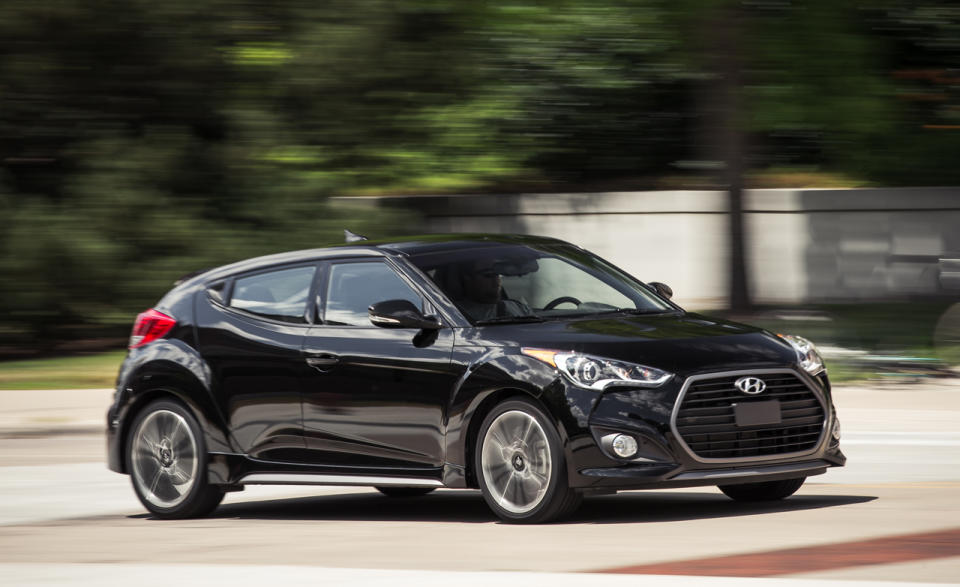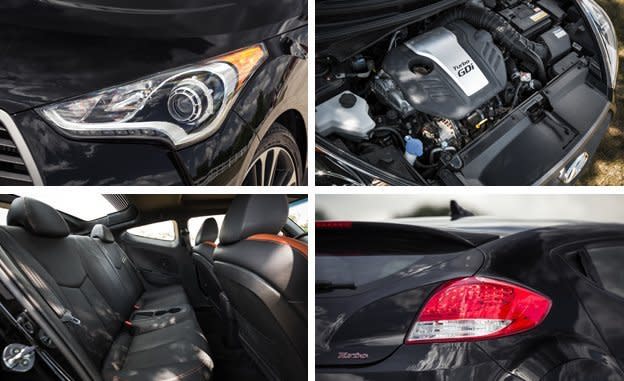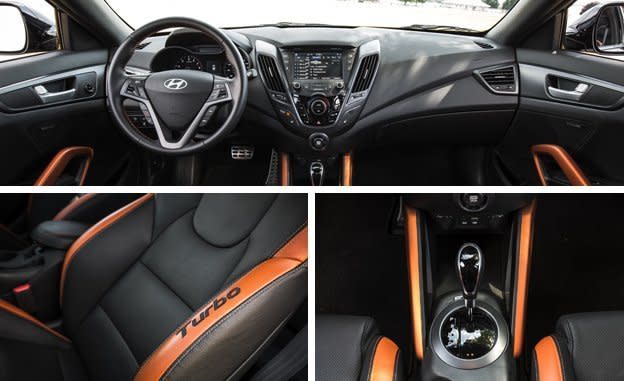2016 Hyundai Veloster Turbo DCT Automatic

The typical new car launches with much fanfare and then goes three or four years with few changes until its “shiny new” wears off. After a few mid-cycle upgrades, it then soldiers on for a few more years until, usually, it is replaced by an all-new version. So logic would suggest that a given car would be best at the end of its life, having undergone all the improvements it can.
So along comes the black-painted 2016 Hyundai Veloster Turbo tested here, de facto inheritor of Hyundai’s performance crown now that the Genesis coupe is gone and the N performance brand has yet to launch. Introduced as a 2012 model and built on the bones of the previous-generation Elantra, the Veloster is now in its twilight years. The asymmetrical three-door hatchback never underwent the typical midlife refresh, yet the car has been steadily improved, most significantly when the trout-faced 201-hp Turbo arrived for 2013. For 2016, Hyundai added a Turbo Rally Edition and replaced the conventional six-speed automatic transmission option with a fresh seven-speed dual-clutch automatic on Turbo models (non-Turbo Velosters have offered a six-speed DCT from the start). Turbos also get new sport seats, wider front tires (now 225/40R-18), and an electroluminescent gauge cluster. We tested a manual-equipped Rally Edition earlier, but this test represented our first opportunity to spend quality time in a Turbo with the new DCT.

This is all promising in the “best at the end of its run” sense, and we were hoping that the dual-clutch transmission might meaningfully nudge the Veloster Turbo in the hot-hatch direction. As it turns out, that logic does not apply. The Turbo DCT turned in some of the worst overall performance numbers of any Turbo model we’ve tested to date, which includes the aforementioned Rally Edition and a pair of Turbos in 2013—one manual, one automatic.
Lag Long and Veloster
First, the new DCT is no threat to the world’s best. The crisp, instantaneous upshifts and happy, throttle-blippy downshifts we’ve come to love in Volkswagens and Porsches with this transmission technology are notably absent. In drive, the dual-clutch feels like a regular automatic, with slurry shifts and a general reluctance to downshift until you’ve mashed the throttle. Sport mode livens things up only slightly. Manual shifts can be summoned by using either squeaky plastic paddles behind the steering wheel or the shift lever. The latter, annoyingly, is tipped away from the driver to engage this mode (perhaps it was designed for drivers who sit on the right?) and serves upshifts by nudging the lever forward and downshifts rearward—the reverse of what most drivers intuitively prefer. Unfortunately, in no mode does the DCT act with real decisiveness. Catch the engine without the turbo spinning, and the transmission can feel as indecisive in its deliberations as the designers who couldn’t choose between two and four doors. With shift lag and turbo lag, what feels like an epoch can pass before the car obeys commands from the driver’s right foot. At least the turbocharged model sounds good, if artificially so, as tailpipe rumble is amplified through the speakers.
One payoff—more crucial to Hyundai’s regulatory compliance than to the consumer, in this era of cheap gasoline—is that the transition from the conventional six-speed automatic to this seven-speed DCT increases EPA fuel-economy ratings by 2 mpg in the city, now earning 27/33 mpg city/highway. In our admittedly aggressive duty cycle, however, we achieved 23 mpg in mixed driving, which is 1 mpg worse than the 24 we recorded for both the 2016 manual-transmission Rally Edition and the 2013 automatic. It wasn’t difficult to get this car to display better numbers, well above 30 mpg, on its trip computer during highway driving, but it takes abnormally large throttle inputs to get it to move away from a stop, so in-town driving took its toll on our average.
Which points up why the DCT didn’t deliver at the track, either. From a standstill, this Veloster accelerated to 60 mph in 7.2 seconds, 100 mph in 19.8, and through the quarter-mile mark in 15.6 seconds at 91 mph. The manual-equipped 2016 Rally Edition hit those targets in 6.7 seconds, 16.8 seconds, and 15.0 seconds at 94 mph. The 2013 Turbo automatic did the same in 6.8 seconds, 20.4 seconds, and 15.4 seconds at 91 mph.

The DCT Turbo is simply a slug out of the hole, requiring high-rpm engagement to get it to launch with any urgency whatsoever. Most people don’t drive that way. Once it’s rolling, the DCT’s 5-to-60-mph figure of 7.7 seconds (versus 8.0 for the 2013 automatic) and its arrival at 120 mph fully 3.5 seconds sooner tell us that the new transmission does indeed hand gears off more quickly. The clock doesn’t lie, but the car feels no quicker in regular driving.
While its front, driven wheels now wear wider rubber, we suspect this Veloster would have fared better with the grippy 215/40R-18 Michelin Pilot Super Sport summer tires that were on the 2013 automatic we tested. Those tires—a $1200 option offered only in 2013—not only helped it achieve quicker off-the-line launches but also gripped the skidpad tenaciously to the tune of 0.90 g versus this car’s 0.85 g. With the summer tires, 70-to-zero-mph braking took only 161 feet compared with the manual cars’ 173- and 185-foot stops and this DCT version’s simply abysmal 191 feet. At least tires are one of the few upgrades owners can make themselves after leaving the dealership.
So it’s a lackluster performer. As it turns out, it’s just mediocre around town, too. Most who drove it noted an unduly harsh ride and vague, overboosted steering with a tendency to wander on the highway. Apart from the classy-looking new gauges, the interior design is a throwback to a decade ago, with a preponderance of hard plastic and cupholders that lack interior grips to hold drink containers in place. Regardless of one’s aesthetic sensitivities, it’s hard to see out of this thing with its low roof and thick pillars obstructing outward vision in nearly every direction. The new sport seats are delightful except for the indignity of displaying the word “turbo” on their side bolsters.
Staffers are mixed on the exterior, too. Some think it looks whimsical and fun, while others feel it tries too hard, emphasizing difference just for the sake of being different. The small rear passenger-side door isn’t ideal for access to the back seat, but it’s certainly easier than using the single, longer door on the driver’s side. Once installed, two average-size adults fit reasonably well back there, albeit with precious little space between their heads and the rear glass. A Veloster also can hold a generous 16 cubic feet of stuff in its deep cargo space, once you’ve lifted it over the high sill.

Our Veloster came with the $2700 Technology package, which brings a panoramic sunroof (giving us a good view out in one direction, at least), automatic climate control, navigation, HD Radio, automatic headlamps, reverse sensors, and Hyundai’s Blue Link telematics system with a three-month trial. A set of carpeted floor mats for $125 brought the total to $27,460, making this the most expensive Veloster we’ve tested. We can think of many competitors for which we’d rather drop that kind of coin: The Volkswagen GTI with the DSG starts at $26,915, or one could try to find one of the final Scion tC Release Series 10.0 models, which were offered earlier this year at $25,135 in automatic form. The 268-hp Subaru WRX CVT might make a worthwhile stretch at $30,890 in order to get the extra power and all-wheel traction.
We’ve had five years to warm up to the Veloster, and Hyundai has had the same amount of time to make it better at the end of its life than at the beginning. Neither has happened. We have higher hopes for the Elantra Sport sedan that’s coming with more than 200 horsepower, an optional seven-speed dual-clutch automatic (which we hope works better than this one does), and the benefits of the Elantra’s new platform. The only Veloster attribute it seemingly will lack is funkiness, however you value that.
Specifications >
VEHICLE TYPE: front-engine, front-wheel-drive, 4-passenger, 3-door hatchback
PRICE AS TESTED: $27,460 (base price: $24,635)
ENGINE TYPE: turbocharged and intercooled DOHC 16-valve inline-4, aluminum block and head, direct fuel injection
Displacement: 97 cu in, 1591 cc
Power: 201 hp @ 6000 rpm
Torque: 195 lb-ft @ 1750 rpm
TRANSMISSION: 7-speed dual-clutch automatic with manual shifting mode
DIMENSIONS:
Wheelbase: 104.3 in
Length: 167.3 in
Width: 71.1 in Height: 55.1 in
Passenger volume: 90 cu ft
Cargo volume: 16 cu ft
Curb weight: 2984 lb
C/D TEST RESULTS:
Zero to 60 mph: 7.2 sec
Zero to 100 mph: 19.8 sec
Zero to 120 mph: 34.9 sec
Rolling start, 5–60 mph: 7.7 sec
Top gear, 30–50 mph: 3.8 sec
Top gear, 50–70 mph: 4.5 sec
Standing ¼-mile: 15.6 sec @ 91 mph
Top speed (drag limited): 134 mph
Braking, 70–0 mph: 191 ft
Roadholding, 300-ft-dia skidpad*: 0.85 g
FUEL ECONOMY:
EPA city/highway driving: 27/33 mpg
C/D observed: 23 mpg
*Stability-control-inhibited

 Yahoo Autos
Yahoo Autos 